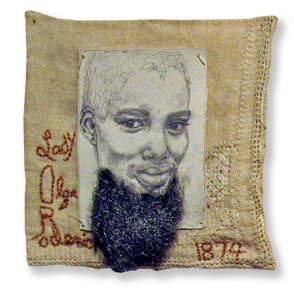| Sun | Mon | Tue | Wed | Thu | Fri | Sat |
|---|---|---|---|---|---|---|
| 1 | 2 | 3 | 4 | 5 | ||
| 6 | 7 | 8 | 9 | 10 | 11 | 12 |
| 13 | 14 | 15 | 16 | 17 | 18 | 19 |
| 20 | 21 | 22 | 23 | 24 | 25 | 26 |
| 27 | 28 | 29 | 30 | 31 |
CATEGORIES
RECENT ENTRIES
BLOG ROLL
Hairy tales
 Artist Barbara Siegel, AB’69, is inspired by extraordinary people. Her installation “Women with Beards,” for example, focuses on 12 real-life bearded ladies, most from the 19th century: “This was the heyday of uninhibited exploitation of these women by men—often their husbands—for financial gain,” says Siegel. But the mystique of female facial hair persists: “Women with Beards” also features two contemporary bearded ladies (one performs in a Coney Island sideshow), whose audio interviews supplement the show. A member of New York City’s A.I.R. Gallery, the first women’s cooperative gallery in the country, Siegel is showing selections from this project as part of Locks in Translation, an exhibition that explores hair from 11 female artists’ points of view. Through March 10, Locks in Translation is showing at Suffolk County [NY] Community College’s Gallery West.
Artist Barbara Siegel, AB’69, is inspired by extraordinary people. Her installation “Women with Beards,” for example, focuses on 12 real-life bearded ladies, most from the 19th century: “This was the heyday of uninhibited exploitation of these women by men—often their husbands—for financial gain,” says Siegel. But the mystique of female facial hair persists: “Women with Beards” also features two contemporary bearded ladies (one performs in a Coney Island sideshow), whose audio interviews supplement the show. A member of New York City’s A.I.R. Gallery, the first women’s cooperative gallery in the country, Siegel is showing selections from this project as part of Locks in Translation, an exhibition that explores hair from 11 female artists’ points of view. Through March 10, Locks in Translation is showing at Suffolk County [NY] Community College’s Gallery West.
In an interview with UChiBLOGo, Siegel talks facial hair and wonders what it means to be a “freak.”
Has any particular story stuck with you?
Lady Olga Roderick was the bearded woman who performed in Tod Browning’s 1932 classic horror movie Freaks. This movie—which I first saw when I was an undergraduate at the U of C in the ‘60s—made a lasting impression on me. In researching contemporary narratives for my project, I discovered that even though the film portrays the “normal” characters as monstrous and is sympathetic to the plight of “freaks,” Lady Olga felt exploited and hated her role in the film. Her words, “If the truth was known, we’re all freaks together,” are a concise reminder that underneath it all, we are fundamentally very much the same.
What media did you use for each piece?
Antique fabrics seemed appropriate because most of the women lived in the 19th century. I embroidered the names and dates of these women onto the fabric because embroidery is a skill associated with women of an earlier era. The “beards” are made of steel wool and copper wire because, though hair-like, they are clearly phony. Jennifer Miller, one of the two contemporary women in my project, told me that drunk and rowdy members of the crowd at sideshows would often harass bearded ladies by coming up and yanking on their beards to try to prove they were fake.
Do you feel a connection with the bearded women?
Definitely! As an adolescent, I suffered from the usual massive array of body-image problems. I was also an artist and therefore a total outsider in a high school where football players and cheerleaders ruled. Finally, I am a member of A.I.R., founded 35 years ago because at that time, women artists were largely belittled or dismissed.
How would you describe your own hair?
Long, thick, and curly. I really appreciate it now, but when I was in college, the preferred look was long, straight, bohemian hair. Many girls I knew ironed their hair to achieve this look. My own method was to wind my wet hair around huge, round rollers that made me look like Minnie Mouse.
Ruth E. Kott, AM'07
February 17, 2010
